Related Research Articles
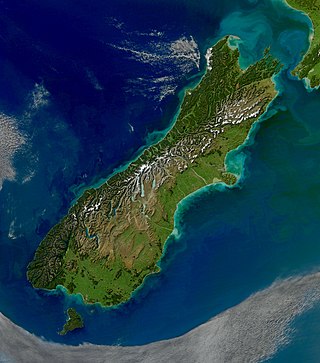
The South Island, also named Te Waipounamu in Māori, is the larger of the two major islands of New Zealand in surface area, the other being the smaller but more populous North Island. It is bordered to the north by Cook Strait, to the west by the Tasman Sea, and to the south and east by the Pacific Ocean. The South Island covers 150,437 square kilometres (58,084 sq mi), making it the world's 12th-largest island, constituting 56% of New Zealand's land area. At low altitude, it has an oceanic climate.
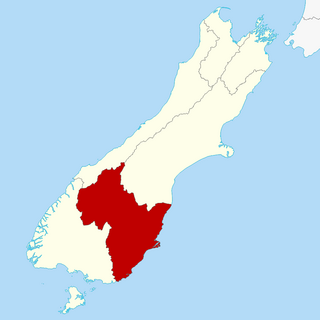
Otago is a region of New Zealand located in the southern half of the South Island administered by the Otago Regional Council. It has an area of approximately 32,000 square kilometres (12,000 sq mi), making it the country's second largest local government region. Its population was 254,600 in June 2023.

Waikouaiti is a small town in East Otago, New Zealand, within the city limits of Dunedin. The town is close to the coast and the mouth of the Waikouaiti River.

The Otago Peninsula is a long, hilly indented finger of land that forms the easternmost part of Dunedin, New Zealand. Volcanic in origin, it forms one wall of the eroded valley that now forms Otago Harbour. The peninsula lies south-east of Otago Harbour and runs parallel to the mainland for 20 km, with a maximum width of 9 km. It is joined to the mainland at the south-west end by a narrow isthmus about 1.5 km wide.

Dunedin is the second-largest city in the South Island of New Zealand, and the principal city of the Otago region. Its name comes from Dùn Èideann, the Scottish Gaelic name for Edinburgh, the capital of Scotland. The city has a rich Māori, Scottish, and Chinese heritage.
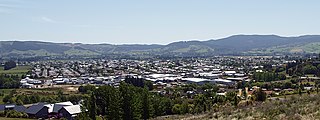
Mosgiel is an urban satellite of Dunedin in Otago, New Zealand, fifteen kilometres west of the city's centre. Since the re-organisation of New Zealand local government in 1989 it has been inside the Dunedin City Council area. Mosgiel has a population of approximately 14,800 as of June 2023. A nickname for Mosgiel is "The pearl of the plain". Its low-lying nature does pose problems, making it prone to flooding after heavy rains. Mosgiel takes its name from Mossgiel Farm, Ayrshire, the farm of the poet Robert Burns, the uncle of the co-founder in 1848 of the Otago settlement, the Reverend Thomas Burns.

The New Zealand sea lion, once known as Hooker's sea lion, and as pakake or whakahao (male) and kake (female) in Māori, is a species of sea lion that is endemic to New Zealand and primarily breeds on New Zealand's subantarctic Auckland and Campbell islands, and have in recent years been slowly breeding and recolonising around the coast of New Zealand's South and Stewart islands. The New Zealand sea lion numbers around 12,000 and is one of the world's rarest sea lion species. They are the only species of the genus Phocarctos.
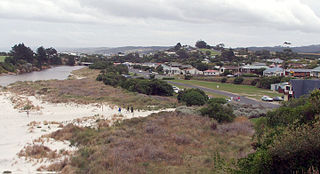
Brighton is a small seaside town within the city limits of Dunedin on New Zealand's South Island. It is located 20 kilometres southwest from the city centre on the Southern Scenic Route.
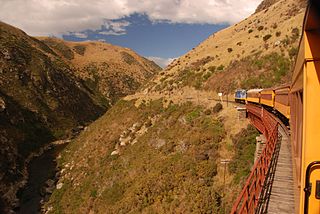
Dunedin Railways is the trading name of Dunedin Railways Limited, an operator of a railway line and tourist trains based at Dunedin Railway Station in the South Island of New Zealand. The company is a council-controlled trading organisation wholly owned by Dunedin City Council through its holding company Dunedin City Holdings Limited.

The Silverpeaks is an area of rough forest and tussock and scrub covered hill country inland and to the northwest of Dunedin, New Zealand. The area is largely uninhabited; the main indication of human activity is the Taieri Gorge Railway, which preserves the route of the former Otago Central Railway that runs along the steep-sided valley of the Taieri River. Much of the area lies within the Silverpeaks Scenic Reserve.

Taieri Mouth is a small fishing village at the mouth of the Taieri River, New Zealand. Taieri Island (Moturata) lies in the ocean several hundred metres off the river's mouth.

The Strath Taieri is a large glacial valley and river plateau in New Zealand's South Island. It is surrounded by the rugged hill ranges to the north and west of Otago Harbour. Since 1989 it has been part of the city of Dunedin. The small town of Middlemarch is located at its southern end.

Dunedin railway station is a prominent landmark and tourist site in Dunedin, a city in the South Island of New Zealand. It is speculated by locals to be the most photographed building in the country, as well as the second most photographed in the southern hemisphere, after the Sydney Opera House.

Dunedin Airport, officially Dunedin International Airport, also known as Momona Airport, is an international airport in the Otago region of the South Island of New Zealand, serving Dunedin city and the Otago and Southland regions. Dunedin Airport is one of two international airports in Otago, the other being Queenstown International Airport. It is located adjacent to the village of Momona on the Taieri Plains approximately 22 kilometres south west of Dunedin CBD. It is the fifth busiest airport in New Zealand by passengers.
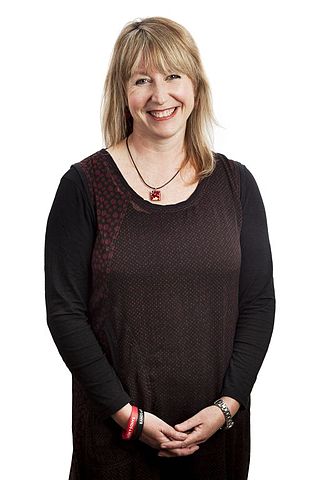
Clare Elizabeth Curran is a New Zealand former politician who served as a member of the New Zealand Parliament for Dunedin South from 2008 to 2020. She was the Minister of Broadcasting, Communications, and Digital Media and Associate Minister for the Accident Compensation Corporation in the Sixth Labour Government of New Zealand. Curran retired from politics at the 2020 general election.

Michael Allan Woodhouse is a former New Zealand politician. He was a Member of Parliament for the National Party from 2008 to 2023.
Taieri is a parliamentary electorate in the Otago region of New Zealand, initially from 1866 to 1911, and was later recreated during the 2019/20 electoral redistribution ahead of the 2020 election.
Isabella Anderson was a New Zealand pioneer. She gave birth to the first Pakeha child born in Dunedin.

Ingrid Marieke Leary is a New Zealand politician. In 2020 she was elected as a Member of Parliament in the House of Representatives for the Labour Party.

Scott Matthew Willis is a New Zealand energy analyst and politician, representing the Green Party of Aotearoa New Zealand as a Member of Parliament since the 2023 New Zealand general election.
References
- 1 2 3 4 "Looking back at the mother of all sea lions on the Otago coast". 1 News. Archived from the original on 30 December 2023. Retrieved 30 December 2023.
- 1 2 Fox, Rebecca (17 September 2008). "Sexy dummy sea lions to lure stayaway males". Otago Daily Times Online News. Archived from the original on 10 March 2024. Retrieved 10 March 2024.
- 1 2 3 "Relief as Mum the sea-lion matriarch returns despite losing her pup". The New Zealand Herald . 22 January 2007. Archived from the original on 10 March 2024. Retrieved 10 March 2024.
- 1 2 "Biology of New Zealand sea lion". www.doc.govt.nz. Archived from the original on 10 March 2024. Retrieved 10 March 2024.
- 1 2 3 4 Chamberlain, Rhys (14 July 2015). "Sea lion statue immortalises 'Mum'". Otago Daily Times Online News. Archived from the original on 10 March 2024. Retrieved 10 March 2024.
- 1 2 Priestley, Laine (9 December 2023). "30km walk a tribute to inspirational Mum". Otago Daily Times Online News. Archived from the original on 10 March 2024. Retrieved 10 March 2024.
- ↑ "Sea lion statue a step closer". Otago Daily Times Online News. 22 September 2014. Archived from the original on 10 March 2024. Retrieved 10 March 2024.